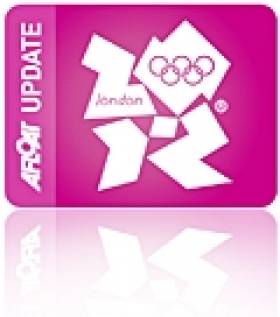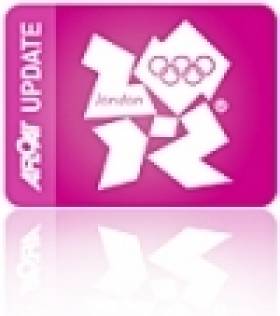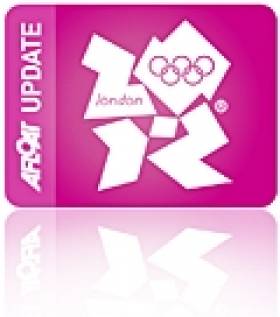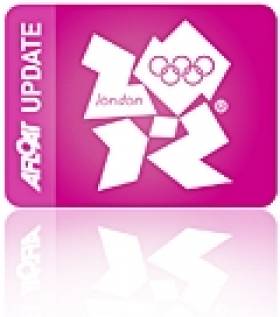Displaying items by tag: Olympics
Murphy Wins UK Laser Qualifier
National Yacht Club Olympic campaigner Annalise Murphy won the UK Laser Radial Qualifiers in North Wales at the weekend. It was a short, sharp affair with no wind in Pwhelli on Saturday. She scored a 1,1,6 in the three races on Sunday sailing in a southerly 15-knot breeze and in a mixed fleet of 79 entrants.
There was no doubt that race two of the series was owned by Murphy who had finished 55th in the first race according to a UK Laser report. Murphy's upwind speed put the rest of the fleet to shame and she pulled well clear leaving the rest of the fleet to scrap over the minor places. Brewster who has been training with Murphy in Ireland obviously had some of the strong wind technique rubbed off on her to take second with Phil McCoy coming in third.Race three and Hannah Snellgrove had the best start but Murphy footed off underneath and with the first shift tacked and was never seen again. Harvey showed that he can not only perform in the light but also the wind, putting in a convincing second, with Olly Porter taking third.
Race four and Murphy was unable to clear the pin at start time and had to tack duck the whole fleet, leaving her to claw her way back through the fleet which was being initially led by Harvey. The battle at the final windward mark was between Porter and Harvey who were well clear of the chasing pack, with Emmett holding off Murphy for third. This time downwind Porter got the better of Harvey, securing the bullet with Harvey second. This was more than enough for Harvey to take the event with Porter's bullet putting him into second. Murphy had a disappointing downwind to finish seventh and a drop to third overall.
However upon returning ashore it transpired that Harvey had been black flagged, promoting Emmett to second in the race. This dropped Harvey to fifth overall and promoted Murphy to take the event on tie breaker!
Overall results:
1st Annalise Murphy 8pts
2nd Olly Porter 8pts
3rd Andrea Brewster 11pts
4th Cameron Douglas 12pts
5th Ross Harvey 13pts
6th Hannah Snellgrove 17pts
Murphy (21) is in Weymouth today at a two week training camp before Ireland's first Olympic qualification event at the Delta Lloyd regatta in Holland. It's a process however that has got easier for the Dun Laoghaire sailor following the withdrawal of the Belfast lough campaigner Tiffany Brien.
Far from hanging up her boots though Brien was back on home waters winning the Laser Radial Ulster Championships at Royal North Ireland YC, Cultra last weekend.
O'Leary and Burrows Lie Fourth at Bacardi Cup
Peter O'Leary and David Burrows lie fourth overall at the halfway stage of the Star class Bacardi Cup in Miami today having posted a 7, 2 and 5 in the 93-boat fleet. Promisingly for the Cork-Dublin duo their top results have also been achieved across the wind range, a fact that must bode well for the remaining three races of the series on Biscayne Bay. Full Results HERE. A podcast with Olympic team manager James O'Callaghan is below:
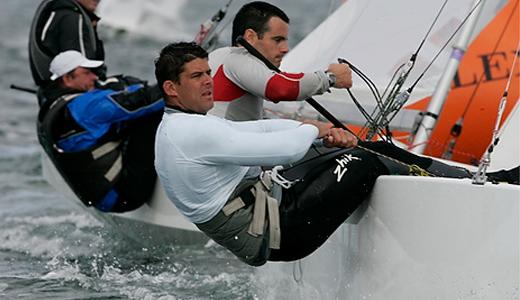
Peter O'Leary and David Burrows - fourth at the half way stage of the Bacardi Cup. Photo: Ingrid Abery. More HERE
Murphy Moves into Third in Miami
Two seconds in today's Laser Radial racing on Biscayne Bay give Dun Laoghaire's Annalise Murphy third overall at Miami Olympic Classes Regatta but the news in the Star class is not as good after Ireland's Peter O'Leary and David Burrows nosedive after a Black Flag Disqualification in race four.
Single hander Murphy, from the National YC, is racing in a highly competitive 58-boat fleet that is led by Belgium's Evi Van Acker. Winds over 16 knots ideally suited the National YC sailor wh now counts a 5, 15 and the two second places. Results HERE.
O'Leary and Burrows dropped from fourth to 23rd after counting a 28th and the Black Flag result today in their 56-boat fleet. Results HERE.

Annalise to leeward in a start in great conditions in Miami. Photo: Daniel Forster/Rolex
Irish Sailors Encamped in Fremantle
The Irish Times reports that Ireland's sailing team have encamped to Fremantle in western Australia for some invaluable training ahead of the ISAF World Championships in Perth next year.
Though the Irish contingent is a much smaller one than that at Weymouth in August - the scheduled venue for sailing at the 2012 Olympics - and reports of shark sightings and attacks in the area are apparently on the rise, those who did make the trip were determined not to waste the opportunity.
“Between the breeze and the nice temperature our training is much more effective than back at home,” said 49er skiff crewer Matt McGovern.
He joins fellow 49er Ryan Seaton and Laser Radial sailor Annalise Murphy at the Perth International Regatta this week. Single-hander Ross Hamilton is also competing but outside the auspices of the Irish Sailing Association’s Olympic group.
Double WIns on Saturday Lines up Titles for Slingsby and Schierup
In wind and sea conditions on Hayling Bay which were a virtual facsimile of previous perfect days, Slingsby seemed to have speed to burn. He finished a long way clear of his nearest rivals on the water in both races.
Now it would appear he just needs to stay clear of trouble and press the 'repeat play' button to be sure of equalling the three world titles tally of his compatriot Glenn Bourke. If he were to be successful it would be the perfect 26th birthday present to himself tomorrow.
After a Black Flag disqualification Friday Slingsby chose to start conservatively today and to then use his speed advantage upwind in the 13-15kts easterly breeze and a decent sized swell.
Sadly for Skandia Team GBR's defending World Champion Paul Goodison, his challenge to Slingsby evaporated on the first run of the first race of the day. Having worked his way up to fourth from a solid start Goodison was given his second yellow flag, for excessive body kinetics in the rolling swells of the first run. His second disqualification in as many days plunged the Olympic title holder to lie a frustrating 19th overall.
His compatriot Nick Thompson, the 2009 ISAF World Cup winner who finished third overall in Halifax last year, lies second overall but admitted to a real mix of emotions when he landed back at Hayling Island Sailing Club.
When he had needed to really impose himself on the first beat of the first race of the day in order to accelerate his title challenge, instead he found himself having to choose to do penalty turns for an infringement, starting up the first beat from last, 55th, but fighting back to sail his discard, 17th.
Thompson came back to a useful 12th in the second heat, preserving a strong set of scores in his armoury, 14 points clear of the St Tropez based French sailor Jean-Baptiste Bernaz.
Bernaz has 18th as his Worlds best, was 31st last year, and finished eighth at the 2008 Olympic regatta in Qingdao, but after a 15th and third today now needs to hold off the immediate challenge to his podium finish from Cyprus' Pavlos Kontides who lies fourth.
Punchy starting was the key to back-to-back wins in the Junior World Championships first two finals races by Thorbjoern Schierup. The Dane's double bullet day sees him moving ahead of Italy's longstanding championship leader Francesco Marrai.
The oscillating breeze offered the quick starters an early opportunity to establish an early lead. Schierup was quickest off the line then unleashed his excellent downwind speed to record his to wins, now six points clear.
Britain's Alex Mills-Barton lies third, 13pts ahead of Croatia's Filip Jurisic.
Quotes
Tom Slingsby (AUS): "It was 15-16kts, nice waves, sunny a really good day for me. The first race I got a nice start near the pin end and worked the left side of the course and opened up a nice lead which I held. The second race I was not so good off the start line but got the first big shift on the first beat and I just lead to the top mark. I got overtaken by the German Philip Buhl on the down the run and overtook him on the next beat. I could not have asked for anything more today.
Definitely today the key was keeping clean around the course. I know I have plenty of speed so I just have to keep clear lanes, stay a little back off the start lines, I already have one yellow flag and so I am keeping my body kinetics to a minimum so I was just trying to do the small things well and that definitely worked.
Paul I saw him get that yellow flag and a little relief goes because I know how dangerous he is, he can be 30 points behind and still be a threat, but he is just one of 10 boats which can be threat, so there are plenty of other guys out there.
I need to keep myself clean again tomorrow, to knock in a good first race, and then I can assess after that.
I am really superstitious. I try to do it all the same every time, to stick to the same processes, so that is not necessarily a good thing going into the last day of an event. If some little thing goes wrong it might mess with me a little, but I am not too phased if it does not go well I won't get too bent out of shape.
Tomorrow's my birthday and the last day of the Worlds, so a big day!
But I can easily lose. In 2006 I lead for seven days of an eight day event and lost on the eight day. All I am thinking about it doing the simple things right, and keeping clean.
I am really fighting for every spot, even if I am back in the pack tomorrow I'll be fighting for every point come the end of the regatta.
What we did last week, even when we had a good lead, was no ever spoke about winning the regatta, we were all still on edge, trying to do our jobs as best we can. And that is what I am going through here, don't think about the result, just think about the process."
Paul Goodison (GBR): "The first race looked like it was panning out to plan. I got a good start and was steadily pulling through the fleet and was probably up to fourth place and I got my second yellow flag and that really was it all over after that. So now it is just getting round and finishing it all off. I think Tom has got the title wrapped up from here, so congratulations to him. He just has to hold it together and my regatta is over from here.
I think it's a tricky call. In 15-16knots with big waves downwind the boats are rocking around and everybody is trying to make the boats go fast, and so I think it is a bit harsh, it's a jury decisions so there is nothing I can do about it, I just have to get on with it.
I feel a bit gutted. Here, I wanted to do my best and unfortunately I haven't been able to do that because of the decisions, but in all fairness to Tom he is sailing well and thoroughly deserves it.
I don't think I am too far off. I have not done as much Laser sailing recently as some of the guys out there, so we are there or thereabouts two years out from the Games I am in with a good shot."
Nick Thompson (GBR): "Mixed emotions for me today. First race I got a good start and just infringed somebody slightly and through it best to do some turns. I managed to pull way back from there, really deep at the mark rounding, to a 17th, so that was a really good race. The second one I was just in touch but just not quite there, just outside the top 10. But, really a tough day. Going in to the final day in second is great. I was looking for a top three at this regatta and that would be good. I think the best thing is my discards are not too bad.
Tomorrow will be like starting a new regatta, trying to get consistent results and see how I lie after the first race. I quite enjoy the breeze, but so does Tom Slingsby which is a little bit frustrating, he is sailing really well."
Jean-Baptiste Bernaz (FRA): "I made good starts and went fast. I am not so surprised to be doing well, but I am maybe a little surprised that I have been able to be so consistent. If you are consistent you do well. We trained here at a Qualifier here in June, but we only came here three days before the regatta. Tomorrow I'll just be trying to sail the same as I have and see how we go. I prepared well for Beijing, but since then we have been working hard to sail well in the stronger breezes so I feel like I'm well prepared for tomorrow no matter what."
"Last year I was in the 30's but here I am stronger, heavier, fitter and sailing better."
Thorbjoern Schierurp (DEN): "The starts were really important so that you could get out to tack on the first windshift, and if you could do that it was just wait for the next one. There were some big shifts, maybe 10 degrees coming in on the whole course, and if you could be the first one to get that, you were gone.
It is not a surprise to be this far up, my aim was top three all the time, and so I am pretty happy so far. Now I just have to go the whole way. Myself and the Italian guy are pretty even. Today I got the better starts and that made the difference."
Francesco Marrai (ITA): "I was not so fast in the first race. In the second race I was better so I discard the first race. Tomorrow I don't know it will be better than today. Today he was really fast on the downwind and he just stayed ahead. For sure today I can say he was the best."
Laser Standard Men's World Championships Hayling Island, UK
Standings after 12 races inc 4 of 6 Finals races
1 Tom Slingsby (AUS) 1,8,(29),3,1,1,5,1,(BFD),8,1,1= 30pts
2 Nick Thompson (GBR) 2,3,(25),6,9,7,9,8,4,2(17),12,=62pts
3 Jean-Baptiste (FRA) (33),2,14,12,5,1,(19),3,15,6,15,3=78pts
4 Pavlos Kontides (CYP) 4,3,21,4,5(27),1,1,10,15,(36),13 = 77pts
5 Andrew Murdoch (NZL) 6,4,11,2,8,(22),9,1,(24),14,8=87pts
6 Tonci Stipanovic (CRO) (19),14,15,4,1,8,2,11,3,13,(32),17=88pts
7 Joshua Junior (NZL) 3,22,1,2,7,5,8,(29),12,21,(25),7=88pts
8 Andrew Maloney (NZL) 2,(22),4,10,2,11,3,4,20,5,(37),35=96pts
9 Julio Alsogaray (ARG) 8,(39),11,17,17,6,23,5,(DNC),7,3,5 = 102pts
10 Andreas Geritzer (AUT),(33),6,2,1,2,(22),9,9,(37),16,16,25 = 108pts
Laser Junior World Championships
1 Thorbjorn Schierup (DEN) 3,3,6,(19),6,2,6,4,1,1 = 26pts
2 Francesco Marral (ITA) 2,3,(7),5,5,3,1,1(17),6 = 26pts
3 Alex Mills-Barton (GBR) 12,(BFD),5,2,1,(21),1,1,15,4 = 41pts
4 Filip Jurisic (CRO) 7,(35),1,27,1,(29),3,5,8,2 = 54pts
BBC To Air Skandia Sail for Gold Regatta
The BBC is set to broadcast two documentaries on Olympic Classes sailing, produced by Sunset+Vine|APP in association with BBC Sport. Part 1 of “Olympic Sailing” will air this Saturday, 21 August , at 1300 on BBC 1. It tells the story of Britain’s medal winners at the Skandia Sail for Gold Regatta where nearly 1000 sailors from 57 nations competed at the Weymouth and Portland National Sailing Academy, the venue for the sailing competition for the London 2012 Games.
The documentary will follow the highs and lows of this international competition that includes Britain’sBeijing gold medalliists Ben Ainslie, Iain Percy and Sarah Ayton plus a host of medallists from the 2008 Games, as they compete on home waters exactly two years ahead of the London 2012 sailing competition.
BBC cameras were invited behind the scenes into the Skandia Team GBR camp for an exclusive tour of the new team accommodation just metres away from the Olympic venue where Shirley Robertson – herself a double Olympic gold medallist - discovers the systems the British team have put in place in order to have the best chance of winning medals. She meets Skandia Team GBR’s newest support crew member, falconer Brian Williams, who with his birds of prey at six o’clock in the morning take on the dawn chorus of local seagulls in a bid to provide the sailors with their last hours of valuable sleep.
The documentary catches up with medal-winning husband and wife team Nick Dempsey and Sarah Ayton, and joins Ainslie, Percy and his crew Andrew ‘Bart’ Simpson for an insight into what makes this renowned team tick. Shirley also meets the young British team sailors struggling to get into the elite squad and earn themselves a place in the main squad where no stone is left unturned in the quest for medals.
The Skandia Sail for Gold regatta was the largest ISAF Sailing World Cup event in 2010, and provided an insight for many 2012 teams into the future Olympic venue.
On Sunday 5 September at 1400 on BBC 2, “OLYMPIC SAILING” (Part 2) will come from Hayling Island on the final day of the Laser World Championships where Beijing gold medallist Paul Goodison is out to defend his title. The programme will also include features on the man to break Ben Ainslie’s six-year winning record in the Olympic Finn class, 23 year-old British sailor Giles Scott, and on perhaps the happiest medal winner of all at the last Games – Britain’s Britain's Bryony Shaw who windsurfed to bronze in China.
BROADCAST TIMES:
“OLYMPIC SAILING” (Part 1) Saturday 21 August 1300 – 1350, BBC1
“OLYMPIC SAILING” (Part 2) Sunday 5 September – 1400, BBC2
BOTH PROGRAMMES CAN BE WATCHED ON BBC iPLAYER after transmission dates
Irish 49ers Move up Scoreboard
Ireland's 49er campaigners Ryan Seaton and Matt McGovern made moves on the top half of the fleet at the 49er Europeans yesterday, with three top 15 results propelling them into 40th overall. They still have some way to go to make the top 25 for the gold fleet, however. Youth sailors Ed Butler and Ben Lynch made positive moves also with a string of results in the mid-twenties moving them up to 62nd.
Results from the event are available as a pdf download HERE.
Slow Start for 49ers in Poland
Ireland's 49er crews have a long way to go if they are to qualify for the gold fleet in the European Championships, being held in Gdynia, Poland.
Olympic campaigners Ryan Seaton and Matt McGovern are top Irish at the moment, but in 52nd of 82 boats, they are still some way off the gold standard, with just 25 boats going through into the gold fleet.
Class chairman Marcus Spillane, sailing with Amish Ved, is in 67th, with Ed Butler and Ben Lynch in 78th overall.
Results are HERE.




























